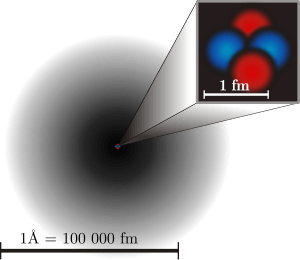Plum pudding model facts for kids
The plum pudding model was an early idea about what an atom looked like. It was created by a scientist named J. J. Thomson in 1904. At that time, scientists knew about tiny, negatively charged particles called electrons. They also knew that atoms were usually neutral, meaning they had an equal amount of positive and negative charge. But they didn't know where the positive charge came from.
Thomson's model suggested that an atom was like a big, positively charged cloud or "pudding." Inside this pudding, the tiny negative electrons were scattered around, like plums in a Christmas pudding. This idea helped explain how atoms could be neutral. However, scientists later found out this model was not quite right.
Contents
How Our Idea of the Atom Changed
Rutherford's Gold Foil Experiment
In 1909, just a few years after Thomson's model, two scientists, Hans Geiger and Ernest Marsden, did an important experiment. Their professor, Ernest Rutherford, asked them to shoot tiny particles at very thin sheets of gold. Rutherford expected the particles to go straight through, proving Thomson's model.
But the results were very surprising! Most particles went through, but some bounced back or changed direction. In 1911, Rutherford realized this meant atoms must have a tiny, dense, positively charged center. He called this center the nucleus. He also figured out that the electrons orbited around this nucleus, much like planets orbit the sun.
Niels Bohr's Energy Levels
Rutherford's model was a big step forward, but it had a problem. Electrons are negatively charged, and the nucleus is positively charged. So, electrons should be pulled into the nucleus. In 1913, Niels Bohr improved the model by adding "energy levels."
Bohr suggested that electrons don't just orbit anywhere. They stay in specific energy levels or shells around the nucleus. To move to a higher energy level, an electron needs to gain energy. To move to a lower level, it must release energy, often as a tiny packet of light called a photon. This new model was called the Bohr model or the Rutherford-Bohr model. It also helped start a new field of science called quantum physics.
The Modern Quantum Model
In 1926, Erwin Schrödinger added another important idea to the atomic model. He suggested that electrons act like both a wave and a particle at the same time. This is known as wave-particle duality.
Because electrons can act like waves, we can't know their exact position at all times. Instead, we can only know the probability of finding an electron in a certain area around the nucleus. This idea is part of what's called quantum uncertainty. The modern atomic model, based on these ideas, shows electrons in "electron clouds" or "orbitals" where they are most likely to be found.
Related pages
Images for kids
See also
 In Spanish: Modelo atómico de Thomson para niños
In Spanish: Modelo atómico de Thomson para niños




